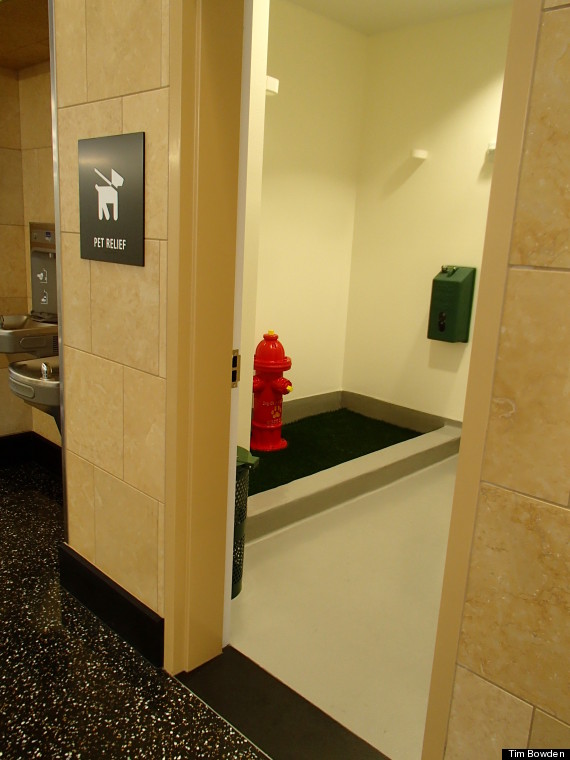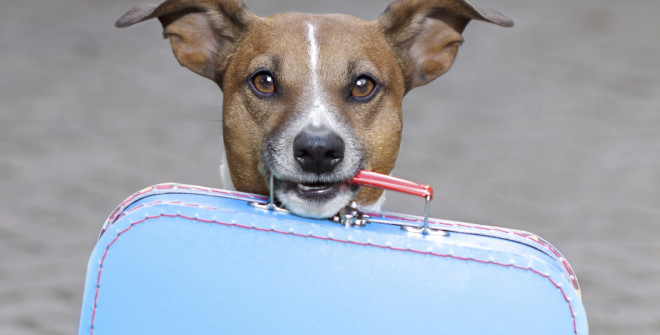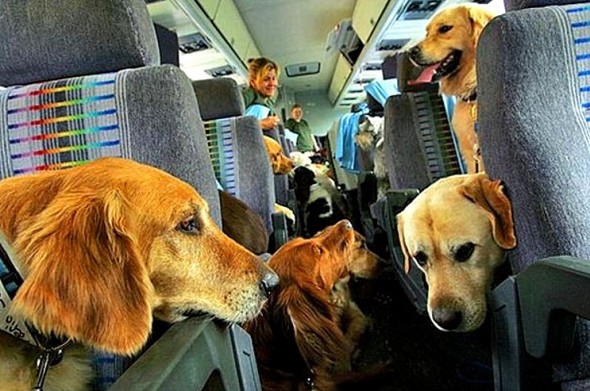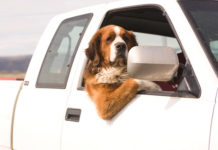Is your dog collecting frequent flyer miles yet?
It is estimated that in the last ten years over 300 pets have died in the U.S. while being transported by airlines. This number is likely higher, because only since 2015 the U.S. Department of Transportation requires air carriers to report incidents involving the loss, injury or death of an animal. These statistics are now published in the monthly Air Travel Consumer Report, available at www.dot.gov/airconsumer.
As a consequence Delta has changed the rules on flying with your fury family member. Effective March 2016 they no longer allow pets in their crates to be checked in with the passenger luggage, due to the deaths and disappearances of countless pets. If your pet is small enough to fit comfortably in a carry on kennel, then this is your best option. For a one-way fee of $ 125 your pet can fly with you in the cabin and you can watch out for each other. The carrier needs to be placed underneath the seat, so double check with your airline about the exact dimensions. Unfortunately, large dogs are still not allowed in the cabin with most airlines, unless they are certified service or therapy dogs. In this case you will need an appropriate harness with an extension to clip into your seat belt, which will provide the necessary safety during takeoff and landing.
Pet owners can still transport their larger pets with Delta Cargo, which is a safer alternative, where pets are handled in temperature-controlled holding areas or vans and are monitored by service teams. The risk of your pet getting lost is the greatest when in transit, so always opt for a nonstop flight and have your pet micro-chipped. GPS Tracking is available now for an additional fee with many airlines.

Temperature and air pressure can fluctuate in the cargo bay and generally have no heat or air conditioning, which can easily become a life threatening situation for senior pets and animals with health issues. Prolonged exposure to low temperatures can cause cold injuries and lead to hypothermia, especially with hairless breeds or dogs with a very thin single coat such as the Greyhound, Doberman, Weimaraner or Pit Bull. It is therefore a good idea to pack a thick blanket and to purchase an insulating mat like a half-size ridge-rest to make them more comfortable. Even when your pet is travelling with you in the cabin, the floor can be quite cold and cause joint inflammations.
While in transit, heat can also become a problem in particular in the summer months and for the short-nosed breeds like the Bulldog, Pekinese or St. Bernard. They are not as efficient in cooling themselves down by panting and are more susceptible to heatstroke. To make matters worse cargo areas are kept unventilated in order to help prevent fires. Make sure your container has enough ventilation openings, ideally on all four sides, and meets the requirements of the U.S. Department of Agriculture (USDA) and IATA Live Animal Regulations (LAR). To ensure water is available, you should fill the kennel dish with water and freeze solid. Then secure the frozen water bowl inside the kennel before check-in.
CAUTION: Never place a leash inside the crate because your pet could become tangled in it and suffocate. Toys or chewing bones are also not a good idea as your pet could choke on them.

One of the most important factors for all travelling animals is easing the stress. Homeopathic drops, natural herbal remedies or essential oils like lavender can help your pet with anxiety. Just like humans, our pets can get nausea from motion. I will never forget my Dobie’s helpless face when I took him to Germany in the cabin and turbulence occurred. There are numerous natural pet products on the market now to help with these issues; be pro-active and prepare for these situations! Do not administer any sedatives or tranquilizers, which slow down the panting process and inhibit the dog’s ability to regulate their body temperature. I also advise familiarizing your pet with the airport by going there couple days before your departure and let them sniff around or say hello to airport staff. Stress and safety risks can also be diminished by choosing the right kennel, which should be sturdy and escape-proof. Your four legged friend should be able to stand and sit erect, turn around, and lay inside the crate without touching the top.
When you go to the airport to familiarize your dog with the new environment, it is a great opportunity exploring pet related services. Hartsfield-Jackson Atlanta Airport for example has a 1,000 sqf fully-fenced in Poochie Park, located in the Ground Transportation Area outside of the Domestic Terminal South. Currently Atlanta has only two pet relieve areas with a little fake fire hydrant, a patch of artificial grass and a water hose for clean up. These are located outside in front of the Domestic Terminal North and the International Terminal. Once you go through security though, there are unfortunately no doggie toilets anymore. I am sure this will improve as many other airports have already implemented pet relief stations inside, where they are most needed. Here is a list of pet friendly airports in the U.S.: http://petfriendlytravel.com/airports.
As a precaution you should not feed your pet on the day of departure and limit the amount of water intake. And needless to say, go on a nice long walk before your journey begins. Equip yourself with some poop bags, paper towels and a little spray bottle of vinegar for clean up, just in case your dog has an accident. You can also buy doggy diapers like the Wiki Wags.
If you have the financial resources, you might want to consider Pet Airways. They offer private chartered flights, where you and your pet can fly together. Their policy is non-discriminating and they will transport any dog, no matter what breed. Companion Air is another airline soon to initiate flights in America.
Whether you fly with a commercial airline or a private jet a Health Certificates must be issued by a licensed and accredited veterinarian within ten days of departure. For identification purposes all pets should be micro-chipped, which must occur prior to rabies vaccinations. And when travelling abroad most countries require a thirty day waiting period after giving the rabies shot, before they can depart. Other vaccinations might be required depending on your destination.

For international flights the Health Certificate also has to be endorsed by the United States Department of Agriculture (USDA). They only have one office for the Atlanta Area the Animal and Plant Health Inspection Service (APHIS), which is located in Conyers. Make sure to download the appropriate forms online at www.aphis.usda.gov/aphis/pet-travel. Another resource is the CDC’s website www.cdc.gov/Features/TravelWithPets/.
I would also recommend contacting the pet related authorities of your destination airport overseas in order to verify that you have the newest regulations. Having this contact in your files is also helpful in case you have any questions or difficulties entering with your pet.
For trips to Europe you should not only look at the EU-Regulations, but double-check any additional requirements with the respective country.
http://ec.europa.eu/food/animals/pet-movement/eu-legislation/non-commercial-non-eu/tpe_en
All this paperwork can be quite overwhelming and you might just don’t want to deal with the hassles of organizing an international trip; Then you can utilize the services of Animal Airways, providing professional flight managers. It is a travel expert at your side and will organize all aspects of your pet’s journey.
Lastly, as a pet first aid instructor the safety and well-being is always on my mind. So ask yourself “Do I really need to take my pet and is it worth the risk just so my pet can be with me?” Be sure to do your homework and plan ahead in order to provide the best possible journey for your paw-some friend. Safe travels!
Yours DobieMom


About DobieMom
Nicole Essawy grew up in Germany and immigrated to the U.S. in 2003. She is a certified Pet Tech Instructor, giving classes on first aid techniques for dogs and cats. Nicole teaches pet parents and





